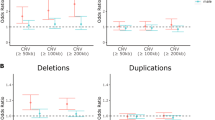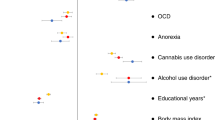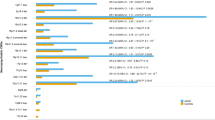Abstract
Attention-deficit/hyperactivity disorder (ADHD) is the most common behavioral disorder in childhood with substantial heritability. Pharmacological and molecular genetic studies as well as characterization of animal models have implicated serotonergic dysfunction in the pathophysiology of ADHD. Here, we investigated the effect of polymorphic variants in the gene of the tryptophan hydroxylase-2 (TPH2), the rate-limiting enzyme of serotonin (5-HT) synthesis in the brain, in children and adolescents with ADHD. We analyzed three single nucleotide polymorphisms (SNPs) in and downstream of the transcriptional control region of the TPH2 gene in 103 families with 225 affected children. Allelic association in families with more than one affected child was assessed using the pedigree disequilibrium test. Preferential transmissions were detected for the two SNPs in TPH2's regulatory region (rs4570625, P=0.049; rs11178997, P=0.034), but not for the third SNP in intron 2 (rs4565946, P=0.3517). Haplotype analysis revealed a strong trend of association between the regulatory region SNPs (rs4570625, rs11178997) and ADHD (P=0.064). Our results link potentially functional TPH2 variations to the pathophysiology of ADHD, and further support the relevance of 5-HT in disorders related to altered motor activity and cognitive processes.
This is a preview of subscription content, access via your institution
Access options
Subscribe to this journal
Receive 12 print issues and online access
$259.00 per year
only $21.58 per issue
Buy this article
- Purchase on Springer Link
- Instant access to full article PDF
Prices may be subject to local taxes which are calculated during checkout
Similar content being viewed by others
References
American Psychiatric Association. Diagnostic and Statistical Manual of Mental Disorders, 4th edn. Text revision. APA Press: Washington, DC, 2000.
Faraone SV, Doyle AE . The nature and heritability of attention-deficit/hyperactivity disorder. Child Adolsc Psychiatr Clin N Am 2001; 10: 2999–2316, viii–ix.
Spencer TJ, Biederman J, Wilens TE, Faraone SV . Overview and neurobiology of attention-deficit/hyperactivity disorder. J Clin Psychiatry 2002; 63 (Suppl 12): 3–9.
Smalley SL . Genetic influences in childhood-onset psychiatric disorders: autism and attention-deficit/hyperactivity disorder. Am J Hum Genet 1997; 60: 1267–1282.
Heiser P, Friedel S, Dempfle A, Konrad K, Smidt J, Grabarkiewicz J et al. Molecular genetic aspects of attention-deficit/hyperactivity disorder. Neurosci Biobehav Rev 2004; 28: 625–641.
Krause KH, Dresel SH, Krause J, Kung HF, Tatsch K . Increased striatal dopamine transporter in adult patients with attention deficit hyperactivity disorder: effects of methylphenidate as measured by single photon emission computed tomography. Neurosci Lett 2000; 12: 107–110.
Giros B, Jaber M, Jones S, Wightman RM, Caron M . Hyperlocomotion and differences to cocaine and amphetamine in mice lacking the dopamine transporter. Nature 1996; 379: 606–612.
Gainetdinov RR, Wetsel WC, Jones SR, Levin ED, Jaber M, Caron MG . Role of serotonin in the paradoxical calming effect of psychostimulants on hyperactivity. Science 1999; 283: 397–401.
Coleman M . Serotonin concentrations in whole blood of hyperactive children. J Pediatr 1971; 78: 985–990.
Bhagavan HN, Coleman M, Coursin DB . The effect of pyridoxine hydrochloride on blood serotonin and pyridoxal phosphate contents in hyperactive children. Pediatrics 1975; 55: 437–441.
Spivak B, Vered Y, Yoran-Hegesh R, Averbuch E, Mester R, Graf E et al. Circulatory levels of catecholamines, serotonin and lipids in attention deficit hyperactivity disorder. Acta Psychiatr Scand 1999; 4: 300–304.
Lesch KP, Merschdorf U . Impulsivity, aggression, and serotonin: a molecular psychobiological perspective. Behav Sci Law 2000; 18: 581–604.
Lesch KP, Zeng Y, Reif A, Gutknecht L . Anxiety-related traits in mice with modified genes of the serotonergic pathway. Eur J Pharmacol 2003; 480: 185–204.
Newman TK, Syagailo Y, Barr CS, Wendland J, Champoux M, Grässle M et al. Monoamine oxidase A gene promoter polymorphism and infant rearing experience interact to influence aggression and injuries in rhesus monkeys. Biol Psychiatry 2005; 57: 167–172.
Retz W, Thome J, Blocher D, Baader M, Rösler M . Association of attention deficit hyperactivity disorder-related psychopathology and personality traits with the serotonin transporter promoter region polymorphism. Neurosci Lett 2002; 319: 133–136.
Bobb AJ, Castellanos FX, Addington AM, Rapoport JL . Molecular genetic studies of ADHD: 1991 to 2004. Am J Med Genet B Neuropsychiatr Genet 2005; 132: 109–125.
Brunner D, Hen R . Insights into the neurobiology of impulsive behavior from serotonin receptor knockout mice. Ann NY Acad Sci 1997; 836: 81–105.
Hawi Z, Dring M, Kirley A, Foley D, Kent L, Craddock N et al. Serotonergic system and attention-deficit/hyperactivity disorder (ADHD): a potential susceptibility locus at the 5-HT1b receptor gene in 273 nuclear families from a multi-centre sample. Mol Psychiatry 2002; 7: 718–725.
Quist JF, Barr CL, Schachar R, Roberts W, Malone M, Tannock R et al. The serotonin 5-HT1B receptor gene and attention deficit hyperactivity disorder. Mol Psychiatry 2003; 8: 98–102.
Walther DJ, Peter JU, Bashammakh S, Hortnagl H, Voits M, Fink H et al. Synthesis of serotonin by a second tryptophan hydroxylase isoform. Science 2003; 299: 76.
Shelton TL, Barkley RA, Crosswait C, Moorehouse M, Fletcher K, Barrett S et al. Multimethod psychoeducational intervention for preschool children with disruptive behavior: two-year post-treatment follow-up. J Abnorm Child Psychol 2000; 28: 253–266.
Barkley RA, Shelton TL, Crosswait C, Moorehouse M, Fletcher K, Barrett S et al. Preschool children with disruptive behavior: three-year outcome as a function of adaptive disability. Dev Psychopathol 2002; 14: 45–67.
Murphy KR, Barkley RA . Parents of children with attention-deficit/hyperactivity disorder: psychological and attentional impairment. Am J Orthopsychiatry 1996; 66: 93–102.
Wechsler D . Examiner's Manual: Wechsler Intelligence Scale for Children, 3rd edn. Psychological Corporation: New York, 1991.
Tewes U, Rossmann R, Schallberger U . Der Hamburg-Wechsler-Intelligenztest fuer Kinder (HAWIK-III). Huber-Verlag: Bern, 1999.
Kaufman AS, Kaufman NL . K-ABC: Kaufman—Assessment Battery for Children. American Guidance Service: Circle Pines, MN, 1983.
Melchers P, Preuss U . K-ABC: Kaufman—Assessment Battery for Children. Deutsche Bearbeitung. Swets & Zeitlinger: Amsterdam, 1994.
Weiss RH . Grundintelligenztest Skala 2 (CFT 20) mit Wortschatztest (WS) und Zahlenfolgentest (ZF). 4., ueberarbeitete Auflage. Westermann: Braunschweig, 1998.
Kaufman J, Birmaher B, Brent D, Rao U, Flynn C, Moreci P et al. Schedule for Affective Disorders and Schizophrenia for School-Age Children—Present and Lifetime Version (K-SADS-PL-D): initial reliability and validity data. J Am Acad Child Adolesc Psychiatry 1997; 36: 980–988.
Delmo C, Weiffenbach O, Gabriel M, Poustka F . 3. Auflage der deutschen Forschungsversion des K-SADS-PL-D, erweitert um ICD-10-Diagnostik Translation and adaptation: Doepfner M and Lehmkuhl G (1998) Diagnostik-System fuer psychische Stoerungen im Kindes- und Jugendalter nach ICD-10 und DSM-IV. Bern: Huber Verlag, 2000.
American Psychiatric Association. Diagnostic and Statistical Manual of Mental Disorders, 3rd edn. (rev ed.), APA Press: Washington, DC, 1987.
World Health Organization. The ICD-10 Classification of Mental and Behavioral Disorders: Diagnostic Criteria for Research. WHO: Geneva, 1993.
Achenbach TM, Edelbrock CS . Psychopathology of childhood. Annu Rev Psychol 1984; 35: 227–256.
Achenbach TM . Empirically Based Taxonomy: How to Use Syndromes and Profile Types Derived from the CBCL from 4 to 18, TRF, and WSR. University of Vermont Department of Psychiatry: Burlington, 1993.
Remschmidt H, Walter R . Psychological symptoms in school children. An epidemiologic study. Z Kinder Jugendpsychiatr 1990; 18: 121–132.
Doepfner M, Lehmkuhl G . Diagnostik-System für psychische Störungen im Kindes- und Jugendalter nach ICD-10 und DSM-IV. Huber: Bern, 1998.
De Luca V, Voineskos D, Wong GW, Shinkai T, Rothe C, Strauss J et al. Promoter polymorphism of second tryptophan hydroxylase isoform (TPH2) in schizophrenia and suicidality. Psychiatry Res 2005; 134: 195–198.
Kennedy MA, Miller AL, Rogers G, Luty S, Mulder R, Joyce P . Polymorphic variants and association analysis of TPH2, brain tryptophane hydroxylase. Neuropsychiatric Genet 2003; 122B: 69.
Mössner R, Walitza S, Geller F, Scherag A, Gutknecht L, Bogusch L et al. Transmission disequilibrium of polymorphic variants in the tryptophan hydroxylase-2 gene in children and adolescents with obsessive-compulsive disorder. Int J Neuropsychopharmacol 2005, in press.
Zhang X, Gainetdinov RR, Beaulieu JM, Sotnikova TD, Burch LH, Williams RB et al. Loss-of-function mutation in tryptophan hydroxylase-2 identified in unipolar major depression. Neuron 2005; 45: 11–16.
O'Connell JR, Weeks DE . PedCheck: a program for identification of genotype incompatibilities in linkage analysis. Am J Hum Genet 1998; 63: 259–266.
Mukhopadhyay N, Almasy L, Schroeder M, Mulvihill WP, Weeks DE . Mega2, a data-handling program for facilitating genetic linkage and association analyses. Am J Hum Genet 1999; 65: A436.
Martin ER, Monks SA, Warren LL, Kaplan NL . A test for linkage and association in general pedigrees: the pedigree disequilibrium test. Am J Hum Genet 2000; 67: 146–154.
Martin ER, Bass MP, Kaplan NL . Correcting for a potential bias in the pedigree disequilibrium test. Am J Hum Genet 2001; 68: 1065–1067.
Boehringer S, Epplen JTM . Genetic association studies of bronchial asthma—a need for Bonferroni correction? Hum Genet 2000; 107: 197.
Nyholt DR . Genetic case–control association studies—correcting for multiple testing. Hum Genet 2001; 109: 564–567.
Knapp M, Becker T . Family-based association analysis with tightly linked markers. Hum Hered 2003; 56: 2–9.
Becker T, Knapp M . Maximum-likelihood estimation of haplotype frequencies in nuclear families. Genet Epidemiol 2004; 27: 21–32.
Zhao H, Zhang S, Merikangas KR, Trixler M, Wildenauer DB, Sun F et al. Transmission/disequilibrium tests using multiple tightly linked markers. Am J Hum Genet 2000; 67: 936–946.
Becker T, Knapp M . A powerful strategy to account for multiple testing in the context of haplotype analysis. Am J Hum Genet 2004; 75: 561–570.
Swanson J, Posner M, Fusella J, Wasdell M, Sommer T, Fan J . Genes and attention deficit hyperactivity disorder. Curr Psychiatry Rep 2001; 3: 92–100.
Lesch KP, Gutknecht L . Focus on the 5-HT1A receptor: emerging role of a gene regulatory variant in psychopathology and pharmacogenetics. Int J Neuropsychopharmacol 2004; 7: 381–385.
Irizarry KJ, Galbraith SJ . Complex disorders reloaded: causality, action, reaction, cause and effect. Mol Psychiatry 2004; 9: 431–432.
Evers EA, Tillie DE, van der Veen FM, Lieben CK, Jolles J, Deutz NE et al. Effects of a novel method of acute tryptophan depletion on plasma tryptophan and cognitive performance in healthy volunteers. Psychopharmacology (Berl) 2005; 178: 92–99.
Hayward G, Goodwin GM, Cowen PJ, Harmer CJ . Low-dose tryptophan depletion in recovered depressed patients induces changes in cognitive processing without depressive symptoms. Biol Psychiatr 2005; 57: 517–524.
Moreno FA, Gelenberg AJ, Heninger GR, Potter RL, McKnight KM, Allen J et al. Tryptophan depletion and depressive vulnerability. Biol Psychiatry 1999; 46: 498–505.
Neumeister A, Nugent AC, Waldeck T, Geraci M, Schwarz M, Bonne O et al. Neural and behavioral responses to tryptophan depletion in unmedicated patients with remitted major depressive disorder and controls. Arch Gen Psychiatry 2004; 61: 765–773.
Puig MV, Celada P, Artigas F . Serotonergic control of prefrontal cortex. Rev Neurol 2004; 39: 539–547.
Barkley RA, Edwards G, Laneri M, Fletcher K, Metevia L . Executive functioning, temporal discounting, and sense of time in adolescents with attention deficit hyperactivity disorder (ADHD) and oppositional defiant disorder (ODD). J Abnorm Child Psychol 2001; 29: 541–556.
Castellanos FX, Tannock R . Neuroscience of attention-deficit/hyperactivity disorder: the search for endophenotypes. Nat Rev Neurosci 2002; 3: 617–628.
Kuntsi J, Oosterlaan J, Stevenson J . Psychological mechanisms in hyperactivity: I. Response inhibition deficit, working memory impairment, delay aversion, or something else? J Child Psychol Psychiatry 2001; 42: 199–210.
Retz W, Retz-Junginger P, Supprian T, Thome J, Rosler M . Association of serotonin transporter promoter gene polymorphism with violence: relation with personality disorders, impulsivity, and childhood ADHD psychopathology. Behav Sci Law 2004; 22: 415–2560.
Zill P, Baghai TC, Zwanzger P, Schüle C, Eser D, Rupprecht R et al. SNP and haplotype analysis of a novel tryptophan hydroxylase isoform (TPH2) gene provide evidece for association with major depression. Mol Psychiatry 2004; 9: 1030–1036.
Harvey M, Shink E, Tremblay M, Gagné B, Raymond C, Labbé M et al. Support for the involvement of TPH2 gene in affective disorders. Mol Psychiatry 2004; 9: 980–981.
Breidenthal SE, White DJ, Glatt CE . Identification of genetic variants in the neuronal form of tryptophan hydroxylase (TPH2). Psychiatr Genet 2004; 14: 69–72.
Lesch KP, Bengel D, Heils A, Sabol SZ, Greenberg BD, Petri S et al. Association of anxiety-related traits with a polymorphism in the serotonin transporter gene regulatory region. Science 1996; 274: 1527–1531.
Fisher SE, Francks C, McCracken JT, McGough JJ, Marlow AJ, MacPhie IL et al. A genomewide scan for loci involved in attention-deficit/hyperactivity disorder. Am J Hum Genet 2002; 70: 1183–1196.
Smalley SL, McGough JJ, Del'Homme M, NewDelman J, Gordon E, Kim T et al. Familial clustering of symptoms and disruptive behaviors in multiplex families with attention-deficit/hyperactivity disorder. J Am Acad Child Adolesc Psychiatry 2000; 39: 1135–1143.
Acknowledgements
We thank all probands for their participation. We thank C Jambor and N Steigerwald for excellent technical assistance. This work was supported by the Deutsche Forschungsgemeinschaft (SFB 581; KFO 125/1-1; SCHA 542/10-2), the Fritz Thyssen Stiftung, the European Commission (NEWMOOD LSHM-CT-2003–503474), the Bundesministerium für Bildung und Forschung (German National Genome Net 01GS0118, 01GR0460) and the Interdisziplinäres Zentrum für Klinische Forschung, Würzburg (N-3; 01KS9603).
Author information
Authors and Affiliations
Corresponding author
Rights and permissions
About this article
Cite this article
Walitza, S., Renner, T., Dempfle, A. et al. Transmission disequilibrium of polymorphic variants in the tryptophan hydroxylase-2 gene in attention-deficit/hyperactivity disorder. Mol Psychiatry 10, 1126–1132 (2005). https://doi.org/10.1038/sj.mp.4001734
Received:
Revised:
Accepted:
Published:
Issue Date:
DOI: https://doi.org/10.1038/sj.mp.4001734
Keywords
This article is cited by
-
Association of tryptophan hydroxylase-2 polymorphisms with oppositional defiant disorder in a Chinese Han population
Behavioral and Brain Functions (2016)
-
Serotonergic modulation of ‘waiting impulsivity’ is mediated by the impulsivity phenotype in humans
Translational Psychiatry (2016)
-
The neurobiological link between OCD and ADHD
ADHD Attention Deficit and Hyperactivity Disorders (2014)
-
Personalized medicine in psychiatry: problems and promises
BMC Medicine (2013)
-
The ADHD-susceptibility gene lphn3.1 modulates dopaminergic neuron formation and locomotor activity during zebrafish development
Molecular Psychiatry (2012)



